2016 Peugeot 308 belt
[x] Cancel search: beltPage 133 of 398
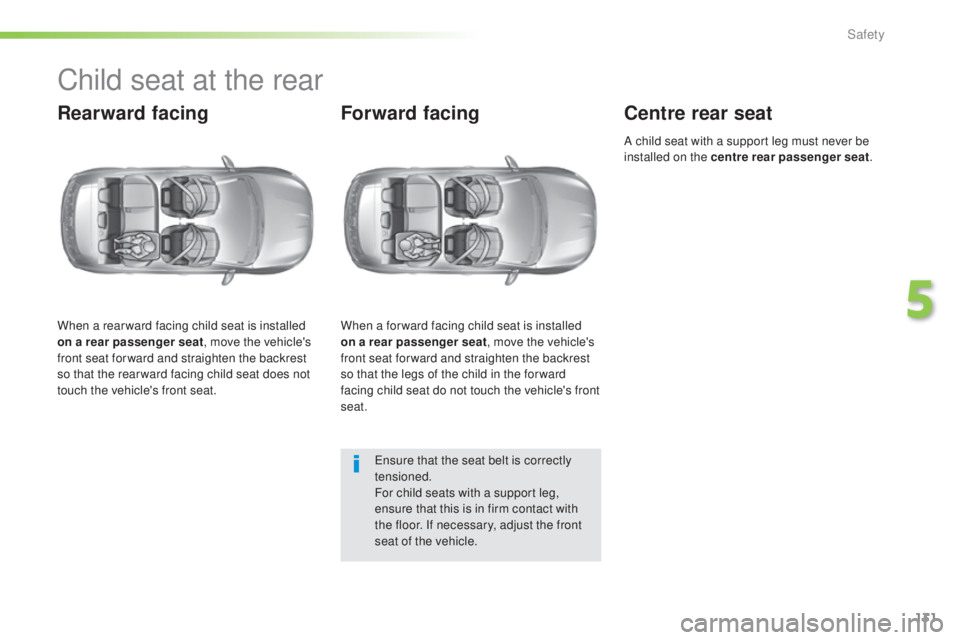
131
308_en_Chap05_securite_ed02-2015
Child seat at the rear
Rearward facing
When a rear ward facing child seat is installed
on a rear passenger seat, move the vehicle's
front seat for ward and straighten the backrest
so that the rear ward facing child seat does not
touch the vehicle's front seat.
Forward facing
When a for ward facing child seat is installed
on a rear passenger seat , move the vehicle's
front seat for ward and straighten the backrest
so that the legs of the child in the for ward
facing child seat do not touch the vehicle's front
seat.
Centre rear seat
A child seat with a support leg must never be
installed on the centre rear passenger seat .
ens
ure that the seat belt is correctly
tensioned.
For child seats with a support leg,
ensure that this is in firm contact with
the floor. If necessary, adjust the front
seat of the vehicle.
5
Safety
Page 134 of 398
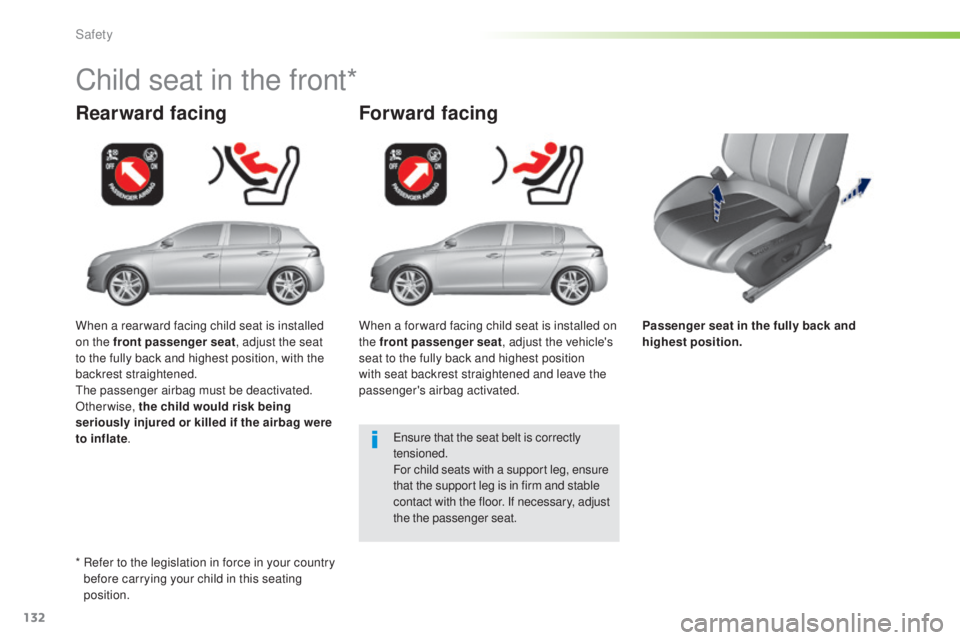
132
308_en_Chap05_securite_ed02-2015
Passenger seat in the fully back and
highest position.
Rearward facing
Child seat in the front*
Forward facing
ensure that the seat belt is correctly
t ensioned.
For child seats with a support leg, ensure
that the support leg is in firm and stable
contact with the floor. If necessary, adjust
the the passenger seat.
When a rear ward facing child seat is installed
on the front passenger seat
, adjust the seat
to the fully back and highest position, with the
backrest straightened.
the p
assenger airbag must be deactivated.
Otherwise, the child would risk being
seriously injured or killed if the airbag were
to inflate . When a for ward facing child seat is installed on
the front passenger seat
, adjust the vehicle's
seat to the fully back and highest position
with seat backrest straightened and leave the
passenger's airbag activated.
*
Re
fer to the legislation in force in your country
before carrying your child in this seating
position.
Safety
Page 138 of 398

136
308_en_Chap05_securite_ed02-2015
Child seats recommended by PeugeOt
PeugeOt offers a range of recommended child seats which are secured using a three point seat belt .
Group 0+: from bir th to 13 kg Groups 2 and 3: from 15 to 36 kg
L1
"RÖM
eR Ba
by-Safe Plus"
Installed in the rearward facing position. L4
"KLIPPAN Optima"
From 22 kg (approximately 6 years), the booster is used on its own. L5
"RÖM
eR KIDF
IX"
Can be fitted to the vehicle's ISOFIX mountings.
the c
hild is restrained by the seat belt.
Safety
Page 139 of 398

137
308_en_Chap05_securite_ed02-2015
Locations for child seats secured with the seat belt
Weight of the child / indicative age
Seat Less than 13 kg
(groups 0 (b) and 0+)
up to 1 ye
ar approx From 9 to 18 kg
(g r o u p 1)
From 1 to 3 years approx
From 15 to 25 kg (group 2)
From 3 to 6 years approx
From 22 to 36 kg (group 3)
From 6 to 10 years approx
Front passenger seat (c) (d)
-
wi
th height adjustment U (R)U (R)U (R)U (R)
-
wi
thout height adjustment
(straightening the backrest) U (R)
U (R)U (R)U (R)
In accordance with the
eur
opean regulation, this table indicates the options for the installation of child seats secured using the seat belt and universally
approved (a) in relation to the weight of the child and the seat in the vehicle.
Hatchback
Outer rear seats (e) UUUU
Centre rear seat (e) U (f )U (f ) XX
SW
Outer rear seats (e) UUUU
Centre rear seat (e) XXXX
5
Safety
Page 140 of 398
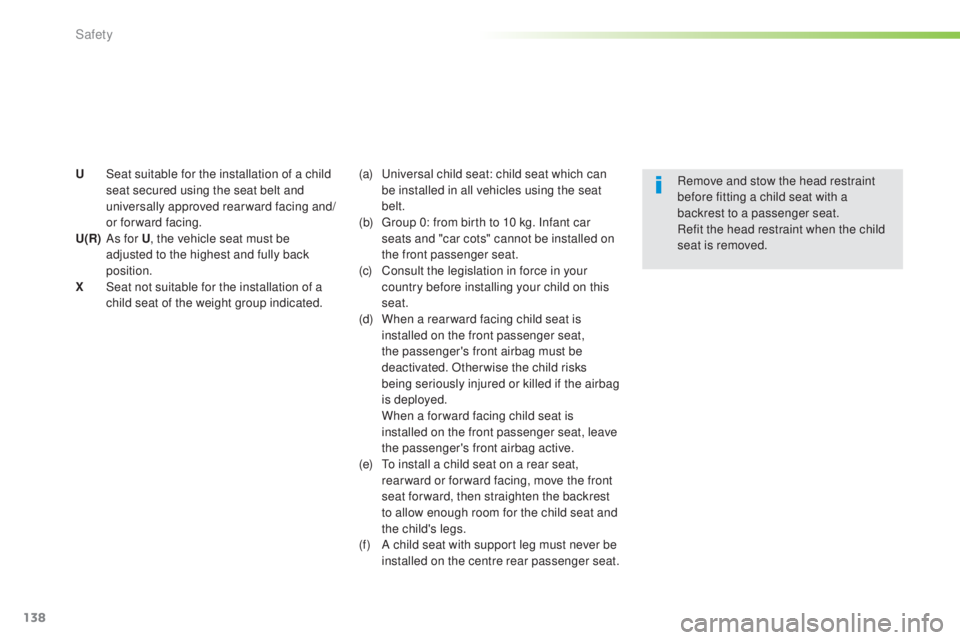
138
308_en_Chap05_securite_ed02-2015
U Seat suitable for the installation of a child
seat secured using the seat belt and
universally approved rearward facing and/
or forward facing.
U(R)
As f
or U, the vehicle seat must be
adjusted to the highest and fully back
position.
X
Se
at not suitable for the installation of a
child seat of the weight group indicated. Remove and stow the head restraint
before fitting a child seat with a
backrest to a passenger seat.
Refit the head restraint when the child
seat is removed.
(a)
uni versal child seat: child seat which can
be installed in all vehicles using the seat
belt.
(b)
g
ro
up 0: from birth to 10 kg. Infant car
seats and "car cots" cannot be installed on
the front passenger seat.
(c)
Co
nsult the legislation in force in your
country before installing your child on this
seat.
(d)
Wh
en a rear ward facing child seat is
installed on the front passenger seat,
the passenger's front airbag must be
deactivated. Otherwise the child risks
being seriously injured or killed if the airbag
is deployed.
Wh
en a for ward facing child seat is
installed on the front passenger seat, leave
the passenger's front airbag active.
(e)
t
o in
stall a child seat on a rear seat,
rear ward or for ward facing, move the front
seat for ward, then straighten the backrest
to allow enough room for the child seat and
the child's legs.
(f)
A ch
ild seat with support leg must never be
installed on the centre rear passenger seat.
Safety
Page 143 of 398
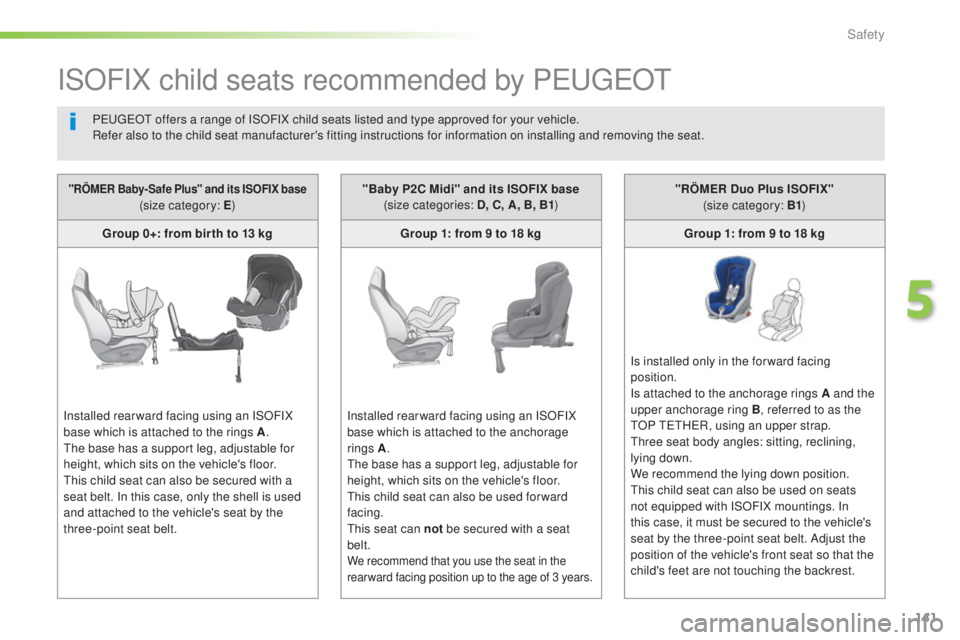
141
308_en_Chap05_securite_ed02-2015
ISOFIX child seats recommended by PeugeOt
PeugeOt offers a range of ISOFIX child seats listed and type approved for your vehicle.
Refer also to the child seat manufacturer's fitting instructions for information on installing and removing the seat.
"RÖMER Baby- Safe Plus" and its ISOFIX base (size category: E)
Group 0+: from bir th to 13 kg
Installed rearward facing using an ISOFIX
base which is attached to the rings A .
the b
ase has a support leg, adjustable for
height, which sits on the vehicle's floor.
thi
s child seat can also be secured with a
seat belt. In this case, only the shell is used
and attached to the vehicle's seat by the
three-point seat belt. "Baby P2C Midi" and its ISOFIX base
(size categories: D, C, A, B, B1 )
Group 1: from 9 to 18 kg
Installed rearward facing using an ISOFIX
base which is attached to the anchorage
rings A .
the b
ase has a support leg, adjustable for
height, which sits on the vehicle's floor.
thi
s child seat can also be used for ward
facing.
thi
s seat can not be secured with a seat
belt.
We recommend that you use the seat in the
rear ward facing position up to the age of 3 years.
"RÖMER Duo Plus ISOFIX" (size category: B1 )
Group 1: from 9 to 18 kg
Is installed only in the for ward facing
position.
Is attached to the anchorage rings A and the
upper anchorage ring B , referred to as the
tOP t
et
HeR, u
sing an upper strap.
thr
ee seat body angles: sitting, reclining,
lying down.
We recommend the lying down position.
thi
s child seat can also be used on seats
not equipped with ISOFIX mountings. In
this case, it must be secured to the vehicle's
seat by the three-point seat belt. Adjust the
position of the vehicle's front seat so that the
child's feet are not touching the backrest.
5
Safety
Page 146 of 398
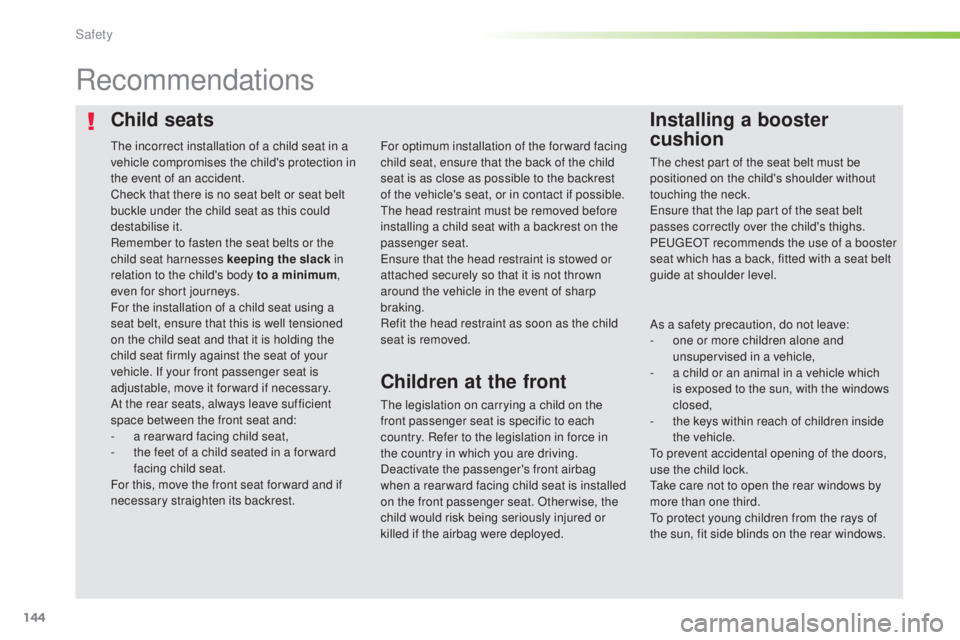
144
308_en_Chap05_securite_ed02-2015
Child seatsInstalling a booster
cushion
Recommendations
the legislation on carrying a child on the
f ront passenger seat is specific to each
country. Refer to the legislation in force in
the country in which you are driving.
Deactivate the passenger's front airbag
when a rear ward facing child seat is installed
on the front passenger seat. Otherwise, the
child would risk being seriously injured or
killed if the airbag were deployed. For optimum installation of the forward facing
child seat, ensure that the back of the child
seat is as close as possible to the backrest
of the vehicle's seat, or in contact if possible.
the h
ead restraint must be removed before
installing a child seat with a backrest on the
passenger seat.
ens
ure that the head restraint is stowed or
attached securely so that it is not thrown
around the vehicle in the event of sharp
braking.
Refit the head restraint as soon as the child
seat is removed.
the i
ncorrect installation of a child seat in a
vehicle compromises the child's protection in
the event of an accident.
Check that there is no seat belt or seat belt
buckle under the child seat as this could
destabilise it.
Remember to fasten the seat belts or the
child seat harnesses keeping the slack in
relation to the child's body to a minimum ,
even for short journeys.
For the installation of a child seat using a
seat belt, ensure that this is well tensioned
on the child seat and that it is holding the
child seat firmly against the seat of your
vehicle. If your front passenger seat is
adjustable, move it forward if necessary.
At the rear seats, always leave sufficient
space between the front seat and:
-
a re
ar ward facing child seat,
-
th
e feet of a child seated in a for ward
facing child seat.
For this, move the front seat for ward and if
necessary straighten its backrest.
Children at the front
the chest part of the seat belt must be
p ositioned on the child's shoulder without
touching the neck.
ens
ure that the lap part of the seat belt
passes correctly over the child's thighs.
P
eu
ge
Ot r
ecommends the use of a booster
seat which has a back, fitted with a seat belt
guide at shoulder level.
As a safety precaution, do not leave:
-
on
e or more children alone and
unsupervised in a vehicle,
-
a ch
ild or an animal in a vehicle which
is exposed to the sun, with the windows
closed,
-
th
e keys within reach of children inside
the vehicle.
to pr
event accidental opening of the doors,
use the child lock.
tak
e care not to open the rear windows by
more than one third.
to pr
otect young children from the rays of
the sun, fit side blinds on the rear windows.
Safety
Page 172 of 398

170
308_en_Chap06_conduite_ed02-2015
Stop & Start
Operation
Going into engine STOP mode
the "ECO" warning lamp comes on
in the instrument panel and the engine
goes into standby automatically:
-
Wi
th a manual gearbox , at speeds below
12 mph (20 km/h) or vehicle stationary
(depending on the engine), when you place
the gear lever in neutral, and you release
the clutch pedal.
Never refuel with the engine in S
tOP
m
ode; you must switch off the ignition
with the button. For your comfort, during parking
manoeuvres, S
tOP m
ode is not
available for a few seconds after
coming out of reverse gear.
S
tOP m
ode does not affect the
functionality of the vehicle, such as for
example, braking, power steering...
A slight delay between the vehicle
stopping and the engine cutting out may
be noticed.
Special cases: STOP mode not
available
StOP mode is not invoked principally when:
- th e vehicle is on a steep slope (up or down),
-
the
driver's door is open,
-
th
e driver's seat belt is not fastened,
-
th
e vehicle has not exceeded 6 mph
(10
k
m/h) since the last engine start by the
driver,
-
th
e electric parking brake is applied or
being applied,
-
th
e engine is needed to maintain a
comfortable temperature in the passenger
compartment,
-
dem
isting is active,
-
som
e special conditions (battery charge,
engine temperature, braking assistance,
ambient temperature...) where the engine is
needed to assure control of a system.
If your vehicle is fitted with Stop & Start,
a time counter calculates the time spent
in S
tOP m
ode during a journey.In this case, the "ECO" warning
lamp flashes for a few seconds then
goes
o
ff.
This operation is perfectly normal.
the S
top & Start
s
ystem puts the engine temporarily into standby - S
tOP m
ode - during stops in the traffic (red lights, traffic jams, or other...).
the e
ngine restarts automatically - S
tARt m
ode - as soon as you want to move off.
the r
estart takes place instantly, quickly and
silently.
Per fect for urban use, the Stop & Start system reduces fuel consumption and exhaust emissions as well as the noise level when stationary.
Stop & Start time
counter
(minutes / seconds or hours / minutes) -
Wi
th an automatic gearbox
, vehicle
stationary, when you press the brake
pedal or place the gear selector lever in
position
N .
I
t resets to zero every time the ignition is
switched on.
Driving